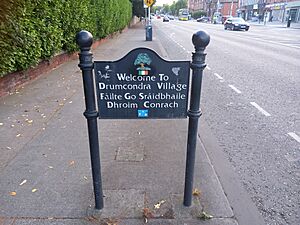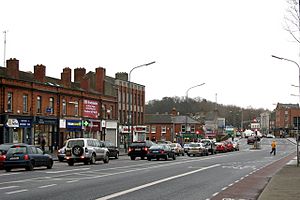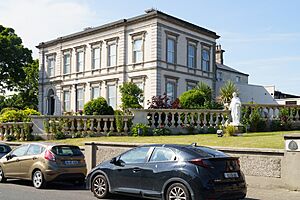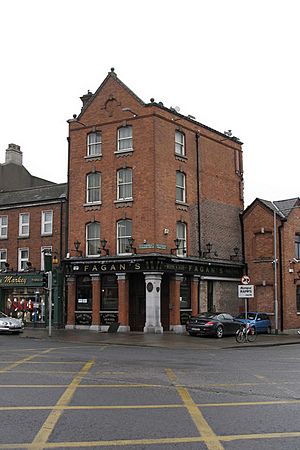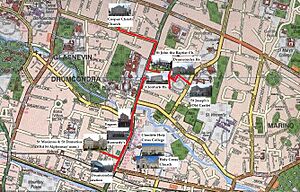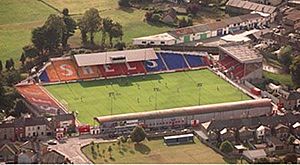Drumcondra, Dublin facts for kids
Quick facts for kids
Drumcondra
Droim Conrach
|
|
|---|---|
|
Inner suburb
|
|
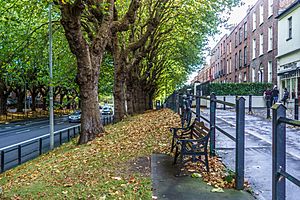
Drumcondra Road Lower
|
|
| Country | Ireland |
| Province | Leinster |
| County | Dublin |
| Local authority | Dublin City Council |
| Elevation | 25 m (82 ft) |
| Population
(2006)
|
|
| • Urban | 8,637 |
| Irish Grid Reference | O158368 |
Drumcondra (Irish: Droim Conrach, meaning Conra's Ridge) is a busy area in the northern part of Dublin, Ireland. It's a place where many people live, close to the city centre. The River Tolka and the Royal Canal both flow through Drumcondra, adding to its charm.
Contents
History of Drumcondra
Drumcondra used to be a small village. It was once known by another name, Clonturk. This name was used for both the local church area and the civil area.
Old Roads and Rebellions
A very old road, called the Slige Midluachra, once passed through Drumcondra. This road was one of the main routes leading into Dublin city. Today, the main road in Drumcondra follows the path of this ancient highway.
The Cat and Cage Pub is a famous spot in Drumcondra. It was once a postal stop. During the 1798 rebellion, rebels stopped a postal cart here. This act was a signal for others in North County Dublin to join the revolt.
Richmond Road connects Drumcondra to Fairview. It was built to give access to Drumcondra Castle. The road got its name from Richmond House, a large house built in the mid-1700s.
Building Homes for Soldiers
After World War I, there was a big need for homes in Ireland, especially in Dublin. Many soldiers were returning from the war and needed places to live. The The Irish Sailors and Soldiers Land Trust (ISSLT) was set up in 1923 to help with this.
The Trust built many new homes across Dublin. Drumcondra was one of the main areas where they built houses. They constructed 66 homes on what is now Lambay Road. These houses were designed to fit in with other homes built by the city. You can still see special plaques on these houses that show they were built by the ISSLT.
Getting Around Drumcondra
Drumcondra has good transport links.
Train Station
The Drumcondra railway station is right on the main road. It first opened in 1901 but closed a few years later. Luckily, it reopened in 1998. Now, it's part of the commuter line that connects places like Maynooth and Longford to Dublin city.
Bus Services
Many Dublin Bus routes serve Drumcondra. These include routes 1, 11, 13, 16, 33, 41, and 41C. There's also an Aircoach service that stops at the railway station. This bus takes you directly to Dublin Airport.
What to See and Do
Drumcondra is home to some very famous places.
Croke Park
One of the biggest attractions is Croke Park. This huge stadium is where Ireland's national sports are played. You can watch exciting games of Gaelic football and hurling here. It can hold over 82,000 people, making it one of Europe's largest sports stadiums. Croke Park is also the main office for the Gaelic Athletic Association (GAA). It has a museum where you can learn all about GAA history.
Local Pubs
Fagan's Public House on Drumcondra Road Lower is a well-known pub. Former Irish leader Bertie Ahern once brought U.S. President Bill Clinton here! Kennedys Pub, also on Lower Drumcondra Road, is even older. It has been called Kennedys since 1961.
Tolka Park
Tolka Park is another important sports venue. It's the home ground for League of Ireland team Shelbourne. This stadium has been used for soccer since the 1920s.
Important Buildings
Belvidere House
Belvidere House is an old building from the late 1600s. It was once a family home. Later, it became a training centre for the Irish Christian Brothers. Today, it's part of Dublin City University (DCU).
Clonturk House
Clonturk House on Ormond Road was built before 1820. It was updated in 1880. The stone railings from James Gandon's Carlisle Bridge (now O'Connell Bridge) were moved here! Over the years, it has been a school and a home for blind men. A famous Dublin character, Thomas Dudley ("Bang Bang"), lived here.
Drumcondra Castle
An older castle was built on this site around 1560. It was owned by the Bathe family for many years. Later, in 1870, it became St. Joseph's Asylum for the Male Blind. Today, the site is home to ChildVision, a school for children with visual impairments. New houses have also been built on the former castle lands.
Drumcondra House
Drumcondra House was built in 1726. It was designed by the famous architect Sir Edward Lovett Pearce. In 1842, All Hallows College was started here. This college was also sold to Dublin City University in 2016.
Carmelite Convent
Hampton House was home to the Carmelite Monastery of the Incarnation for 150 years. This was a place for a special group of nuns. The land and buildings were sold in 2016. Now, new houses and a nursing home are being built there.
Old Distillery
A whiskey distillery, called Dublin Whiskey Distillers (D.W.D.), was built in the 1870s. It was located next to the River Tolka. The distillery closed in 1946. Some of its old buildings are still standing. Many new buildings in the area have names linked to the distillery, like The Corn Mill and The Granary.
Education in Drumcondra
Drumcondra has many schools for different age groups.
Primary Schools
- Drumcondra N.S. (boys and girls)
- St Patrick's N.S. (boys)
- Corpus Christi N.S. (girls)
- St. Joseph's School For Children with a Visual Impairment (boys and girls)
Secondary Schools
- Dominican College Griffith Avenue (Girls)
- PobalScoil Rosmini (mixed)
- Maryfield College (Girls)
Universities
Two parts of Dublin City University are located in Drumcondra:
- All Hallows College
- St Patrick's College, Dublin
Religion
Drumcondra has several churches and religious sites.
Churches
The oldest church is Drumcondra Church (Church of Ireland). Many important people are buried in its graveyard. The "Old Church of St. George" was built around 1668. Its tower can still be seen on Hill Street. The "New Church of St. George" was built in the early 1800s.
Drumcondra is also a parish in the Roman Catholic Archdiocese of Dublin. The Church of Corpus Christi is located on Home Farm Road. The home of the Roman Catholic Archbishop of Dublin is next to Clonliffe College. This college is a seminary, a place where priests are trained.
The Ukrainian Greek Catholic Church also holds services in Holy Cross College, Clonliffe.
Burial Grounds
There are a few small cemeteries in Drumcondra:
- All Hallows College Cemetery
- Cemetery of the Carmelite Monastery of the Incarnation
- Drumcondra Church Graveyard
- St. George Burial ground, near Drumcondra Hospital
- High Park, Graveyard
- St. Joseph's Cemetery (Rosminians)
Sports in Drumcondra
Drumcondra is a great place for sports fans!
Croke Park
As mentioned earlier, Croke Park is a major sports hub. It hosts the finals of the All-Ireland Senior Football Championship and All-Ireland Senior Hurling Championship. These are huge events in Irish sport.
Tolka Park
Tolka Park is the home of Shelbourne, a professional soccer team. They have won the Irish league six times and the FAI Cup four times since moving to Tolka Park. The stadium has even hosted big European clubs!
Another team, Drumcondra F.C. (known as the 'Drums'), used to play at Tolka Park. They were very successful after World War II, winning five Irish league titles. They even played in European competitions. The name Drumcondra FC still exists today.
The Ierne Sports and Social Club is also in Drumcondra. Rosmini Gaels (GAA) is another local sports club.
Famous People from Drumcondra
Many well-known people have lived in or are connected to Drumcondra:
- Bertie Ahern, a former leader (Taoiseach) of Ireland.
- Dermot Bannon, an architect known from TV.
- Dermot Bolger, a writer.
- Richard Bruton, a politician.
- Eamon Dunphy, a famous football player and broadcaster.
- Orla Gartland, a popular singer.
- Aidan Gillen, an actor.
- James Joyce, a world-famous writer, lived here for a time.
- Samantha Mumba, a singer.
- Seán O'Casey, a famous playwright.
- Anthony O'Reilly, a businessman and rugby player.
- Fintan O'Toole, a journalist.
- Rejjie Snow, a rapper.
- Hannah Tyrrell, a Dublin GAA and Irish Rugby player.



